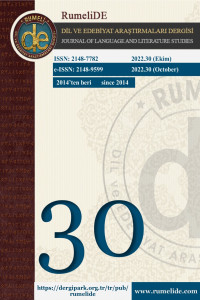Devler Arasında Bir Gezinti: Ovid, Kafka, Auden ve Bruegel’de “Cezalandırma” üzerine karşılaştırmalı bir araştırma
Öz
Dönüşüm kavramını hikayelerinde birleştirici bir unsur olarak kullanan Ovid’in “Metamorphoses”’ı kimlik, ölümsüzlük, şiddet, cezalandırma, ödüllendirme ve erdem gibi birçok sayıda temayı inceler. Yaygın motiflerinden biri olan cezalandırma, Daedalus ve Icarus efsanesinde babasının tavsiyesini dinlemeyen oğulun bir trajedi ile karşı karşıya kalma örneklemesi ile bilhassa dikkat çeker. Bununla birlikte, Franz Kafka’nın The Metamorphosis’ında gezici satış temsilciliği yapan Gregor Samsa’nın bir haşarata dönüşmesi, W.H. Auden’ın “Musee des Beaux Arts”’da kayıtsızlık ve cezalandırma motifinin ön plana çıkması ve son olarak da Pieter Bruegel’in Landscape with the Fall of Icarus tablosunda tepkisizliğin bir cezalandırma olarak tasvir edilmesi, Daedalus ve Icarus hikayesindeki dönüşüm ve cezalandırma motiflerinden esinlenildiğine işaret eder. Bu makale’nin amacı Ovid’in “Metamorphoses”’ında yaygın olarak görülen cezalandırma motifini Franz Kafka’nın The Metamorphosis kısa romanında, W.H. Auden’ın “Musee des Beaux Arts” şiirinde ve Pieter Bruegel’in Landscape with the Fall of Icarus tablosunda incelerken, Kafka’nın The Metamorphosis ve Auden’ın “Musee des Beaux Arts” adlı eserlerindeki başkahramanların davranışsal özelliklerini analiz ederek Sigmund Freud’un kazaların aslında olmadığını addeden “kazalar” teorisinin cezalandırma motifi ile arasındaki bağlantıyı ortaya çıkarmaktır.
Anahtar Kelimeler
Cezalandırma Kazalar Dönüşüm Dönüşümler Musee des Beaux Arts İkarus’un Düşüşü Sırasında Bir Manzara
Kaynakça
- Auden, W. H. (1995), Auden Poems, Musée des Beaux Arts, New York: A.A. Knopf, 72 Biblia. (n.d.), Herod Kills the Children: Matthew 2:16-18, https://biblia.com/books/esv/Lk2.1-5 —. The Birth of Jesus Christ: Luke 2:1-5, (n.d), https://biblia.com/books/esv/Lk2.1-5
- Bruegel, P. (1555), Landscape with the Fall of Icarus (Painting). Royal Museums of Fine Arts of Belgium, Brussels, Belgium. https://www.bl.uk/collection-items/landscape-with-the-fall-of-icarus —. The Census at Bethlehem (Painting). (1566), Royal Museums of Fine Arts of Belgium, Brussels,
- Belgium. https://artsandculture.google.com/asset/the-census-at-bethlehem-pieter-bruegel-the elder/JwGxiyxYTZZEog —. Massacre of the Innocents (Painting). (1565-67), Windsor Castle, Windsor, U.K. https://www.rct.uk/collection/search#/3/collection/405787/massacre-of-the-innocents
- Freud, S. (1901), The Psychopathology of Everyday Life, (A. A. Brill, Trans.), The Psychology E-Book Collection, Hogarth Press, www.all-about-psychology.com
- Kafka, F. (2013), Metamorphosis, Tr. David Wyllie, Maryland: Serenity Publishers.
- Kinney, A.F. (1963), Auden, Bruegel, and “Musée des Beaux Arts”, National Council of Teachers of English, 24(7), 529-531.
- Ovid, (1955), Metamorphoses, Tr. Mary M. Innes, London: Penguin Books.
- Pavlock, B. (1998), Daedalus in the Labyrinth of Ovid’s “Metamorphoses”, The Johns Hopkins University Press on behalf of the Classical Association of the Atlantic States, 92(2), 141-157.
- Royal Collection Trust, (n.d.), Massacre of the Innocents. https://www.rct.uk/collection/405787/massacre-of-the-innocents
- Sokel, W. (1954), Kafka's "Metamorphosis": Rebellion and Punishment, The University of Wisconsin Press, 48(4), 203-214.
Öz
Ovid’s “Metamorphoses” which holds transformation as a unifying element in his stories examines a large number of themes including identity, immortality, violence, punishment, reward and morality. Punishment which is one of the most common motifs, particularly stands out in the myth of Daedalus and Icarus where a son faces tragedy for not taking his father’s advice. Similar motifs of change and punishment appear in Franz Kafka’s novella The Metamorphosis in which a salesman named Gregor Samsa turns into a verminous bug, W.H. Auden’s “Musee des Beaux Arts” poem where indifference and punishment go hand in hand and finally in Pieter Bruegel’s Landscape with the Fall of Icarus painting wherein unresponsiveness is depicted as punishment. The aim of this article is to analyse the common motif of “punishment” in Ovid’s “Metamorphoses”, Franz Kafka’s The Metamorphosis, W.H. Auden’s “Musee des Beaux Arts” with Pieter Bruegel’s Landscape with the Fall of Icarus and to investigate behavioural characteristics of the protagonist in both Kafka’s The Metamorphosis and W.H. Auden’s “Musee des Beaux Arts” according to Sigmund Freud’s theory of “accidents” in order to uncover a connection between the common motif punishment and the theory of accidents in which essentially assume there are none.
Anahtar Kelimeler
Punishment Accidents The Metamorphosis Metamorphoses Musee des Beaux Arts Landscape with the Fall of Icarus
Kaynakça
- Auden, W. H. (1995), Auden Poems, Musée des Beaux Arts, New York: A.A. Knopf, 72 Biblia. (n.d.), Herod Kills the Children: Matthew 2:16-18, https://biblia.com/books/esv/Lk2.1-5 —. The Birth of Jesus Christ: Luke 2:1-5, (n.d), https://biblia.com/books/esv/Lk2.1-5
- Bruegel, P. (1555), Landscape with the Fall of Icarus (Painting). Royal Museums of Fine Arts of Belgium, Brussels, Belgium. https://www.bl.uk/collection-items/landscape-with-the-fall-of-icarus —. The Census at Bethlehem (Painting). (1566), Royal Museums of Fine Arts of Belgium, Brussels,
- Belgium. https://artsandculture.google.com/asset/the-census-at-bethlehem-pieter-bruegel-the elder/JwGxiyxYTZZEog —. Massacre of the Innocents (Painting). (1565-67), Windsor Castle, Windsor, U.K. https://www.rct.uk/collection/search#/3/collection/405787/massacre-of-the-innocents
- Freud, S. (1901), The Psychopathology of Everyday Life, (A. A. Brill, Trans.), The Psychology E-Book Collection, Hogarth Press, www.all-about-psychology.com
- Kafka, F. (2013), Metamorphosis, Tr. David Wyllie, Maryland: Serenity Publishers.
- Kinney, A.F. (1963), Auden, Bruegel, and “Musée des Beaux Arts”, National Council of Teachers of English, 24(7), 529-531.
- Ovid, (1955), Metamorphoses, Tr. Mary M. Innes, London: Penguin Books.
- Pavlock, B. (1998), Daedalus in the Labyrinth of Ovid’s “Metamorphoses”, The Johns Hopkins University Press on behalf of the Classical Association of the Atlantic States, 92(2), 141-157.
- Royal Collection Trust, (n.d.), Massacre of the Innocents. https://www.rct.uk/collection/405787/massacre-of-the-innocents
- Sokel, W. (1954), Kafka's "Metamorphosis": Rebellion and Punishment, The University of Wisconsin Press, 48(4), 203-214.
Ayrıntılar
| Birincil Dil | Türkçe |
|---|---|
| Konular | Dilbilim |
| Bölüm | Dünya dilleri, kültürleri ve edebiyatları |
| Yazarlar | |
| Yayımlanma Tarihi | 21 Ekim 2022 |
| Yayımlandığı Sayı | Yıl 2022 Sayı: 30 |


